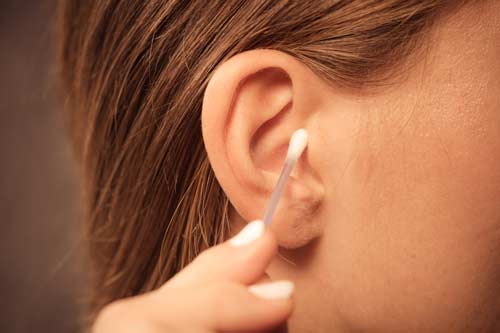You’ve no doubt heard the old adage of “never put anything smaller than your own elbow inside your ear,” while then imagining what that would look like or how to do it. (You just tried it didn’t you)? While it might seem silly it’s actually true. In fact, you shouldn’t ignore it when you read advice from doctors, audiologists like us, and the instructions on a package of Q-tips.
We don’t mean to yell at you but:
Stop Putting Stuff Like Q-Tips In Your Ear!
Seriously, ENTS and audiologists have been warning you for decades not to clean your ears with Q-tips or anything else (except the aforementioned elbow). As recently as Jan of last year, CBS News ran this story about another attempt on the part of the American Academy of Otolaryngology – Head and Neck Surgery about new, patient-friendly guidelines on how to safely remove earwax.
You risk damaging your hearing when you put anything inside your ear
In spite of all the warnings people still continue to clean their ears with not just things like Q-tips, but also keys, toothpicks, bobby pins, toys, including Barbie doll shoes while attempting to remove earwax. In fact, according to a study last year in the The Journal of Pediatrics, between 1990 and 2010 over 263,000 children were treated in emergency rooms for ear injuries related to cotton-tip applicators like Q-tips. The majority of the cases were related to ear cleaning and most of the patients weren’t over the age of 7.
So what exactly were the injuries that happened to people and why did we say that you could be damaging your’s or your child’s hearing by sticking anything inside your ear. Let’s break it down:
- Impacted earwax against your eardrum
- Ear infections
- Perforated eardrums
- Permanent hearing loss
Earwax is actually good for you
No! Don’t eat it. That’s disgusting! What we mean is that earwax, what audiologists and doctors refer to as cerumen, (am I the only person who thinks that sounds like Saruman from The Lord of the Rings), is part of your body’s natural self-cleaning system. It’s water soluble and designed to protect your ear from dirt, debris, bacteria and foreign objects. Most of the time, excess cerumen is washed out naturally when you take a bath or shower. Because of this, there’s no need to use a Q-tip to remove earwax from the inside of your ear canal, ever again.
Even if you do wind up with excess earwax or because you’re addicted to putting stuff into your ear, you’ve already pushed the cerumen further up into your ear canal and it’s causing problems, don’t put anything larger than your elbow into your ear! If you do feel the need to clean your ears, use a soft cloth only to clean the outside part of your ears, and again, never enter the ear canal.
But what do I do if I need to remove it?
This is a good question because like we mentioned, there might be times when excess cerumen is causing problems and needs to be removed by a professional or at the very least your doctor or audiologist may recommend or prescribe earwax removal drops that are safe for you to use at home. We recommend that you only use an at home earwax removal remedy if your doctor or audiologists says it’s safe for you to do so and only the type he or she tells you to use.
That’s because certain types of people should not use at home remedies and besides Q-Tips things like ear candles should never, ever, ever be used to remove earwax or for anything else either. Ear candles can cause injury to your ear canal including burns, ear infections, and eardrum perforation. There’s also zero scientific evidence they cure cancer or any other disease.
When it’s time to contact a professional
If you’re concerned about excess cerumen or you experience any of the following symptoms, you should definitely contact your audiologist (you’re on an audiology website, that’s convenient) or your doctor:
- You’re experiencing a fullness in your ear
- You have pain in your ear
- You feel dizzy
- Your ear itches inside
- Discharge coming from your ear
- Unpleasant odor coming from your ear
- Ringing in your ears
The above symptoms might be related to impacted earwax or could be signs of another problem which is why you should have a doctor or hearing specialist evaluate what’s going on rather than assume it’s earwax.
Additionally, if you’re having problems with your hearing aid it could be because of excess wax build up on your hearing aid and in your ear canal. Don’t attempt to clean your ear canal yourself. Especially don’t use Q-tips or any other object to clean the inside of your ear. Contact your audiologist instead.
Conclusion
We’re not trying to make you feel bad if you’ve been using Q-tips to clean your ears or shame you. We hope that with a little humor and a lot of information on the dangers of putting anything larger than your elbow into your ear to remove earwax or anything else has finally convinced you that you shouldn’t.
Remember, earwax (cerumen, Saruman), is a good for your ears and helps keep them clean. Earwax can build up or become impacted, including to the point of interfering with hearing aid and hearing function. If this happens, don’t take matters into your own hands. Instead, call an audiologist or your doctor and make an appointment. That way they can assess what’s going on, diagnose the problem, and if it is a problem related to earwax, remove the earwax for you.

